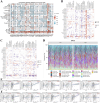BIRC5 as a prognostic and diagnostic biomarker in pan-cancer: an integrated analysis of expression, immune subtypes, and functional networks
- PMID: 39703228
- PMCID: PMC11655497
- DOI: 10.3389/fgene.2024.1509342
BIRC5 as a prognostic and diagnostic biomarker in pan-cancer: an integrated analysis of expression, immune subtypes, and functional networks
Abstract
Introduction: BIRC5 (Survivin) is a crucial anti-apoptotic protein overexpressed in various cancers, promoting tumor growth and treatment resistance. This study investigates its expression across 33 cancer types and explores its diagnostic, prognostic, and immune-related significance.
Methods: We analyzed RNA-seq data from TCGA and protein expression data from the Human Protein Atlas. Expression levels were compared between tumor and normal tissues. Correlations with molecular and immune subtypes were explored using TISIDB. Prognostic significance was evaluated through survival analysis, Cox regression, and ROC curve analysis. The PPI network was constructed using STRING.
Results: BIRC5 was significantly overexpressed in tumor tissues across 33 cancer types, with higher expression levels observed in tumors compared to normal tissues. The protein expression analysis revealed a similar trend. BIRC5 expression was significantly correlated with various molecular and immune subtypes in multiple cancer types. Survival analysis indicated that high BIRC5 expression was associated with poor prognosis across multiple cancers, including lung adenocarcinoma (LUAD) and kidney renal clear cell carcinoma (KIRC). ROC analysis showed that BIRC5 exhibited strong diagnostic potential, with high AUC values (>0.9) in several cancers. The PPI network analysis identified key interacting proteins involved in the cell cycle and tumor progression, further supporting BIRC5's role in cancer biology. Functional experiments in lung adenocarcinoma (LUAD) revealed that BIRC5 upregulation enhances cell proliferation, migration, and invasion, while its knockdown suppresses these activities.
Discussion: BIRC5 is a promising diagnostic and prognostic biomarker in multiple cancers. Its association with immune subtypes suggests a potential role in the tumor immune microenvironment. These findings support BIRC5 as a therapeutic target for cancer treatment.
Keywords: BIRC5; cancer prognosis; diagnostic biomarker; lung adenocarcinoma; tumor immune microenvironment.
Copyright © 2024 Li, Wang, Wang, Lv, Li, Wang, Liu, Yuan, Deng and You.
Conflict of interest statement
The authors declare that the research was conducted in the absence of any commercial or financial relationships that could be construed as a potential conflict of interest.
Figures










References
-
- Bai Z., Zhou Y., Ye X., Li Y., Peng Y., Guan Q., et al. (2022). Survivin suppression heightens BZML-induced mitotic catastrophe to overcome multidrug resistance by removing therapy-induced senescent A549/Taxol cells. Biochimica biophysica acta Mol. cell Res. 1869 (2), 119174. 10.1016/j.bbamcr.2021.119174 - DOI - PubMed
-
- Broodman I., VanDuijn M. M., Stingl C., Dekker L. J., Germenis A. E., de Koning H. J., et al. (2016). Survivin autoantibodies are not elevated in lung cancer when assayed controlling for specificity and smoking status. Cancer Immunol. Res. 4 (2), 165–172. 10.1158/2326-6066.CIR-14-0176 - DOI - PubMed
-
- Chandrasekaran A. P., Tyagi A., Poondla N., Sarodaya N., Karapurkar J. K., Kaushal K., et al. (2022). Dual role of deubiquitinating enzyme USP19 regulates mitotic progression and tumorigenesis by stabilizing survivin. Mol. Ther. J. Am. Soc. Gene Ther. 30 (11), 3414–3429. 10.1016/j.ymthe.2022.07.019 - DOI - PMC - PubMed
-
- Contini C., Manconi B., Olianas A., Guadalupi G., Schirru A., Zorcolo L., et al. (2024). Combined high-throughput proteomics and random forest machine-learning approach differentiates and classifies metabolic, immune, signaling and ECM intra-tumor heterogeneity of colorectal cancer. Cells 13 (16), 1311. 10.3390/cells13161311 - DOI - PMC - PubMed
LinkOut - more resources
Full Text Sources

